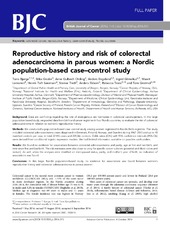Reproductive history and risk of colorectal adenocarcinoma in parous women: a Nordic population-based case–control study
| dc.contributor.author | Bjørge, Tone | en_US |
| dc.contributor.author | Gissler, Mika | en_US |
| dc.contributor.author | Ording, Anne Gulbech | en_US |
| dc.contributor.author | Engeland, Anders | en_US |
| dc.contributor.author | Glimelius, Ingrid | en_US |
| dc.contributor.author | Leinonen, Maarit | en_US |
| dc.contributor.author | Sørensen, Henrik Toft | en_US |
| dc.contributor.author | Tretli, Steinar | en_US |
| dc.contributor.author | Ekbom, Anders | en_US |
| dc.contributor.author | Troisi, Rebecca | en_US |
| dc.contributor.author | Grotmol, Tom | en_US |
| dc.date.accessioned | 2016-11-04T13:09:53Z | |
| dc.date.available | 2016-11-04T13:09:53Z | |
| dc.date.issued | 2016-10-04 | |
| dc.Published | British Journal of Cancer 2016 | eng |
| dc.identifier.issn | 1532-1827 | |
| dc.identifier.uri | https://hdl.handle.net/1956/13056 | |
| dc.description.abstract | Background: Data are conflicting regarding the role of endogenous sex hormones in colorectal carcinogenesis. In this large population-based study, we pooled data from birth and cancer registries in four Nordic countries, to evaluate the risk of colorectal adenocarcinoma in relation to women’s reproductive history. Methods: We conducted a population-based case–control study among women registered in Nordic birth registries. The study included colorectal adenocarcinoma cases diagnosed in Denmark, Finland, Norway, and Sweden during 1967–2013 and up to 10 matched controls per case, in total 22 185 cases and 220 246 controls. Odds ratios (ORs) with 95% confidence intervals (95% CIs) were derived from conditional logistic regression models. We had limited information available on possible confounders. Results: We found no evidence for associations between colorectal adenocarcinoma and parity, age at first and last birth, and time since first and last birth. The risk estimates were also close to unity for specific cancer subsites (proximal and distal colon and rectum). As well, when the analyses were stratified on menopausal status, parity, and mother’s year of birth, no indication of associations was found. Conclusions: In this large, Nordic population-based study, no evidence for associations was found between women’s reproductive history and colorectal adenocarcinoma in parous women. | en_US |
| dc.language.iso | eng | eng |
| dc.publisher | Springer Nature | eng |
| dc.relation.uri | http://www.nature.com/bjc/journal/vaop/ncurrent/pdf/bjc2016315a.pdf | |
| dc.rights | Attribution CC BY | eng |
| dc.rights.uri | http://creativecommons.org/licenses/by/4.0 | eng |
| dc.subject | colorectal cancer | eng |
| dc.subject | reproductive history | eng |
| dc.subject | case–control study | eng |
| dc.subject | Nordic countries | eng |
| dc.title | Reproductive history and risk of colorectal adenocarcinoma in parous women: a Nordic population-based case–control study | en_US |
| dc.type | Peer reviewed | |
| dc.type | Journal article | |
| dc.date.updated | 2016-10-12T12:16:33Z | |
| dc.description.version | publishedVersion | en_US |
| dc.rights.holder | Copyright 2016 The Authors | |
| dc.identifier.doi | https://doi.org/10.1038/bjc.2016.315 | |
| dc.identifier.cristin | 1391241 |

